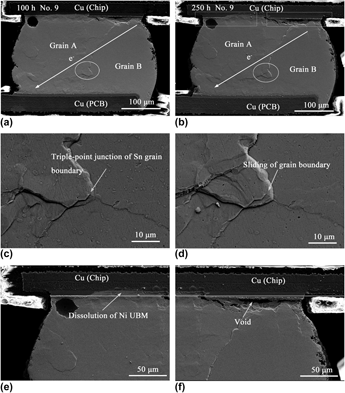Article contents
Stress relaxation and failure behavior of Sn–3.0Ag–0.5Cu flip-chip solder bumps undergoing electromigration
Published online by Cambridge University Press: 08 September 2014
Abstract

The stress relaxation and failure behavior of Ni/Sn–3.0Ag–0.5Cu/electroless nickel electroless palladium immersion gold flip-chip solder bumps undergoing electromigration (EM) at 150 °C under 1.5 × 104 A/cm2 was investigated in situ. Three modes of stress relaxation of Sn–3.0Ag–0.5Cu solder bumps were identified. At the cathode, voids and hollows with terrace morphology gradually formed to relieve the tensile stress; at the anode, especially around the current crowding corner, recrystallization of Sn grains and extrusion of hillocks occurred to relieve the compressive stress; in the solder bump, Sn grain boundary sliding that occurred to accommodate the diffusion creep was more pronounced with increasing EM time. Grain boundary sliding is considered to be an indispensable requisite for diffusion creep. The microstructural evolution of solder bumps at the last stage of lifetime was revealed, and the final EM-induced failure mode was the local fusion of a solder bump resulting from the crack formation-and-propagation at the cathode.
- Type
- Articles
- Information
- Copyright
- Copyright © Materials Research Society 2014
References
REFERENCES
- 3
- Cited by




